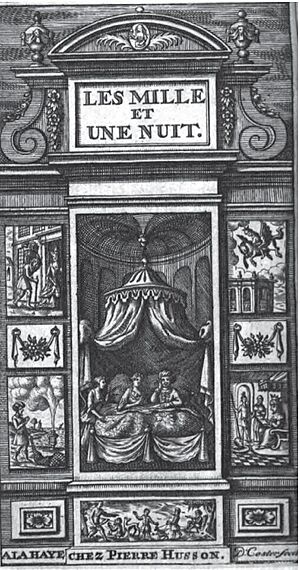Les mille et une nuits facts for kids

Les mille et une nuits, contes arabes traduits en français means "The Thousand and One Nights, Arab stories translated into French." This was the very first European version of the famous One Thousand and One Nights tales. It was published in 12 books between 1704 and 1717.
The French translation was done by Antoine Galland (1646–1715). He used an Arabic text from Syria and other sources. Interestingly, his version included stories not found in the original Arabic writings. These are sometimes called "orphan tales." Famous examples are "Aladdin" and "Ali Baba and the Forty Thieves." These stories first appeared in print in Galland's French books.
This collection of stories became incredibly popular right away. It also had a huge impact on later books and stories. Because it was so successful, publishers sometimes put Galland's name on new volumes. However, these later stories were often written by unknown people. The publishers just wanted to use Galland's fame to sell more books.
Contents
What's in the Book?
This collection of stories was published in 12 different books. It contains many exciting and magical tales from the Middle East. Some of the most well-known stories first appeared in this French version.
Famous Stories You Might Know
Many of the tales in Galland's collection are still popular today. Here are some of the most famous ones:
Sindbad the Sailor
- "The Story of Sindbad the Sailor" tells about a brave sailor's seven amazing journeys. He travels to distant lands and faces many dangers.
- "His First Voyage"
- "The Second Voyage of Sindbad the Sailor"
- "The Third Voyage of Sindbad the Sailor"
- "The Fourth Voyage of Sindbad the Sailor"
- "The Fifth Voyage of Sindbad the Sailor"
- "The Sixth Voyage of Sindbad the Sailor"
- "The Seventh and last Voyage of Sindbad the Sailor"
Aladdin and the Magic Lamp
- "The Story of Aladdin, or the Wonderful Lamp" is a tale about a young boy who finds a magic lamp. A powerful genie lives inside the lamp. The genie grants wishes, leading Aladdin on many adventures.
Ali Baba and the Forty Thieves
- "Tale of Ali Baba and Forty Thieves Exterminated by a Slave" is about a poor woodcutter named Ali Baba. He discovers a secret cave full of treasure. This treasure belongs to a group of forty thieves.
Other Interesting Tales
The collection also includes many other fascinating stories. These often feature genies, kings, merchants, and clever characters.
- "The Story of the Fisherman"
- "The Three Apples"
- "History of the Little Hunchback"
- "The Story of the Barber" (and his six brothers)
- "History of the Enchanted Horse"
How the Books Were Published
First Release
The first books were published in Paris, France.
- From 1704 to 1717: Les mille et une nuit, contes arabes traduits en François, par M. Galland.
- The first six books came out between 1704 and 1705.
- The last two books (volumes 11 and 12) were published in 1717.
Later Editions
- One very long version of Galland's translation is in the Bibliothèque de la Pléiade series. It has 3,504 pages!
- Another well-known edition was published in 1965 by Garnier Flammarrion.

